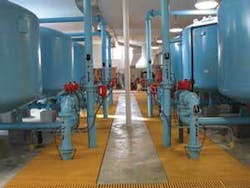Anion Resin System Allows Use of High-TOC Well Water
The plant superintendent for the Dare County/Cape Hatteras Water Treatment Plant in Frisco, NC, reports successful application of an especially long-lasting, strong base anion exchange resin to allow use of high-TOC shallow well water that would otherwise have caused THM and HAA5 formation in excess of maximum contaminant levels.
With no surface water available to meet increasing demand for high-quality drinking water from the coastal community, the Dare County Water System developed a combination source of anion-treated shallow water wells and reverse osmosis (RO)-treated, deeper brackish water wells as the most cost-effective solution.
“Without the anion resin, we couldn’t use as much of the shallow well water because of its TOC problem,” said Terry Goldman, the plant superintendent. “The anion system has been virtually trouble-free, with only a broken lateral that occurred during construction.
“We are still using some of the original resin, greatly exceeding the 5-year life span that was promised, and only replaced the rest after seven years of use. And the anion resin has never required off-line cleaning.”
The total organic carbon of the fresh water coming in to the anion averages about 12-13 mg/l, for an average of 50-60 color units. Coming out, it drops to an average 1-1.5 mg/l TOC, which is essentially colorless. When the water is blended with the output from the RO system in a ratio of about 4:1, the TOC drops down to about 0.85-0.81 mg/l, Goldman said.
“That keeps our THMs in the range of 9-30 ppb, and an average of 12 ppb, vs. the MCL of 80 ppb, and our HAA5s at 2-5 ppb, vs. the MCL of 60 ppb. It also maintains our average finished water total hardness at 65-70 ppm, so we don’t get corrosion problems from using only RO water,” he said.
The 2 mgd, combination RO/anion exchange plant is expandable to 3 mgd. Its output is a blend of RO water that derives from four 260-308 ft. brackish wells, at an average RO exit flow of 800 gpm, with anion water that derives from nineteen 70-90 ft. wells, at an average anion exit flow of 200 gpm.
Chlorine is added to the anion output as an oxidizer for iron and manganese, which is followed by sand filtration before it reaches the ground storage tank. Water from regeneration is pumped to settling basins before discharge. The RO water is treated with chlorine, fluoride, and corrosion inhibitors, and is adjusted for pH before ground storage.
The combination-source plant was developed during 1999-2000 to replace the area’s original, 1.4 mgd average, conventional flocculation, sedimentation, filtration, and softening water treatment plant.
“As we increased demand on the old plant, we had gotten to the point where we were too often exceeding the 80% capacity factor that the state prefers you stay within,” Goldman said, “and I remember one July 4 when we were really right on the edge of capacity. Since the county did not have additional property suitable for shallow wells, and didn’t have any fresh surface water sources, we drilled deep wells into a brackish aquifer for a reverse osmosis water source.
“To do that, we needed to increase the hardness of the RO finished water so it wouldn’t corrode our distribution system. But we couldn’t do that by adding raw brackish water because its salinity was too high, which would have caused us to exceed our 250 ppm chloride MCL.
“And we didn’t want to do it by adding more chemicals. So that led us to anion exchange to take care of the TOC, and allow us to use the available fresh water for blending.
“The anion exchange system works very well--- it has a low energy requirement, is simple to operate and virtually maintenance-free, and gives us a very high-quality blended output for our customers, making up for the moderate recovery rate the RO system provides due to the high salinity of its source water.”
Clarified and filtered fresh shallow well water enters the anion exchange system at a flow rate of about 700 gpm, or 1 mgd. Two 275 cu. ft. columns of resin handle a service flow rate of 2-3 gpm/cu. ft.. Throughput is 14,500 gal./cu. ft.
Regeneration dosage is 8 lbs. salt/ cu. ft.. Estimated salt cost is $0.022/1000 gal., and estimated resin cost is $0.03/ 1000 gal.
The Purolite® A860 Anion Exchange Resin in use here is a macroporous, Type 1 strong-base resin with an acrylic matrix.
The acrylic matrix is said to assure very high levels of removal of organic matter from a water supply in conjunction with their reversible removal upon regeneration, with non- hazardous sodium chloride.
The resin is described as regenerated very efficiently, with lower levels of sodium chloride than those required for a polystyrene-based Type 1 resin, but with a comparable ability to remove weak organic acids, lignins, and tannins.
The resin is also noted as particularly resistant to organic fouling, even when loadings are relatively high.



